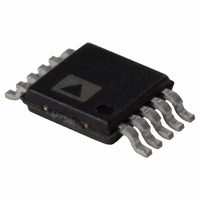AD7992BRM-1 Analog Devices Inc, AD7992BRM-1 Datasheet - Page 9

AD7992BRM-1
Manufacturer Part Number
AD7992BRM-1
Description
IC ADC 12BIT 2CHAN I2C 10MSOP
Manufacturer
Analog Devices Inc
Datasheet
1.AD7992BRMZ-1.pdf
(28 pages)
Specifications of AD7992BRM-1
Number Of Bits
12
Sampling Rate (per Second)
79k
Data Interface
I²C, Serial
Number Of Converters
1
Power Dissipation (max)
2.2mW
Voltage Supply Source
Single Supply
Operating Temperature
-40°C ~ 125°C
Mounting Type
Surface Mount
Package / Case
10-TFSOP (0.118", 3.00mm Width)
For Use With
EVAL-AD7992CB - BOARD EVALUATION FOR AD7992
Lead Free Status / RoHS Status
Contains lead / RoHS non-compliant
TERMINOLOGY
Signal-to-Noise and Distortion Ratio (SINAD)
The measured ratio of signal-to-noise and distortion at the
output of the A/D converter. The signal is the rms amplitude of
the fundamental. Noise is the sum of all nonfundamental signals
up to half the sampling frequency (f
is dependent on the number of quantization levels in the digit-
ization process; the more levels, the smaller the quantization
noise. The theoretical signal-to-noise and distortion ratio for
an ideal N-bit converter with a sine wave input is given by
Thus, the SINAD is 74 dB for a 12-bit converter.
Total Harmonic Distortion (THD)
The ratio of the rms sum of harmonics to the fundamental. For
the AD7992, it is defined as
where V
V
sixth harmonics.
Peak Harmonic or Spurious Noise
The ratio of the rms value of the next largest component in the
ADC output spectrum (up to f
value of the fundamental. Typically, the value of this specification
is determined by the largest harmonic in the spectrum, but for
ADCs where the harmonics are buried in the noise floor, it is a
noise peak.
Intermodulation Distortion
With inputs consisting of sine waves at two frequencies, fa
and fb, any active device with nonlinearities creates distortion
products at sum and difference frequencies of mfa ± nfb, where
m, n = 0, 1, 2, 3, and so on. Intermodulation distortion terms
are those for which neither m nor n equal zero. For example,
second-order terms include (fa + fb) and (fa − fb), while
third-order terms include (2fa + fb), (2fa − fb),(fa + 2fb), and
(fa − 2fb).
The AD7992 is tested using the CCIF standard where two input
frequencies near the top end of the input bandwidth are used.
In this case, the second-order terms are usually distanced in
frequency from the original sine waves while the third-order
terms are usually at a frequency close to the input frequencies.
As a result, the second- and third-order terms are specified
separately. The calculation of intermodulation distortion is,
like the THD specification, the ratio of the rms sum of the
individual distortion products to the rms amplitude of the sum
of the fundamentals, expressed in dB.
4
Signal-to-(Noise + Distortion) = (6.02 N + 1.76) dB
, V
THD
5
, and V
(
1
dB
is the rms amplitude of the fundamental, and V
)
6
=
are the rms amplitudes of the second through
20
log
V
2
2
+
V
S
/2 and excluding dc) to the rms
3
2
+
S
/2), excluding dc. The ratio
V
V
4
1
2
+
V
5
2
+
V
6
2
2
, V
3
Rev. 0 | Page 9 of 28
,
Channel-to-Channel Isolation
A measure of the level of crosstalk between channels, taken
by applying a full-scale sine wave signal to the unselected input
channels, and determining how much the 108 Hz signal is
attenuated in the selected channel. The sine wave signal applied
to the unselected channels is then varied from 1 kHz up to
2 MHz, each time determining how much the 108 Hz signal in
the selected channel is attenuated. This figure represents the
worst-case level across all channels.
Aperture Delay
The measured interval between the sampling clock’s leading
edge and the point at which the ADC takes the sample.
Aperture Jitter
The sample-to-sample variation in the effective point in time
when the sample is taken.
Full-Power Bandwidth
The input frequency at which the amplitude of the reconstructed
fundamental is reduced by 0.1 dB or 3 dB for a full-scale input.
Power Supply Rejection Ratio (PSRR)
The ratio of the power in the ADC output at the full-scale
frequency, f, to the power of a 200 mV p-p sine wave applied
to the ADC V
where Pf is the power at frequency f in the ADC output; Pf
the power at frequency f
Integral Nonlinearity
The maximum deviation from a straight line passing through
the endpoints of the ADC transfer function. The endpoints are
zero scale, a point 1 LSB below the first code transition, and full
scale, a point 1 LSB above the last code transition.
Differential Nonlinearity
The difference between the measured and the ideal 1 LSB
change between any two adjacent codes in the ADC.
Offset Error
The deviation of the first code transition (00…000) to
(00…001) from the ideal—that is, AGND + 1 LSB.
Offset Error Match
The difference in offset error between any two channels.
Gain Error
The deviation of the last code transition (111…110) to
(111…111) from the ideal (that is, REF
offset error has been adjusted out.
Gain Error Match
The difference in gain error between any two channels.
PSRR (dB) = 10 log (Pf/Pf
DD
supply of frequency f
S
coupled onto the ADC V
S
)
S
:
IN
− 1 LSB) after the
DD
AD7992
supply.
S
is












